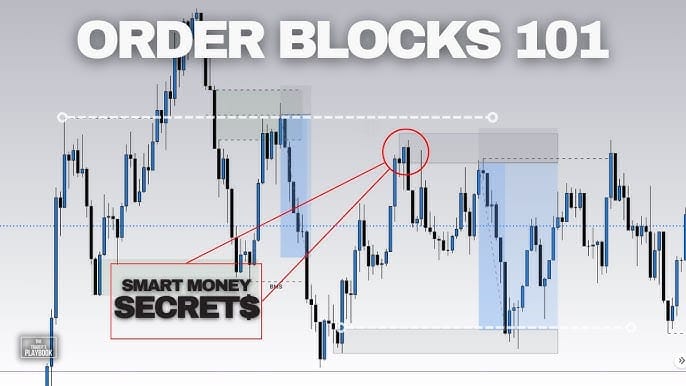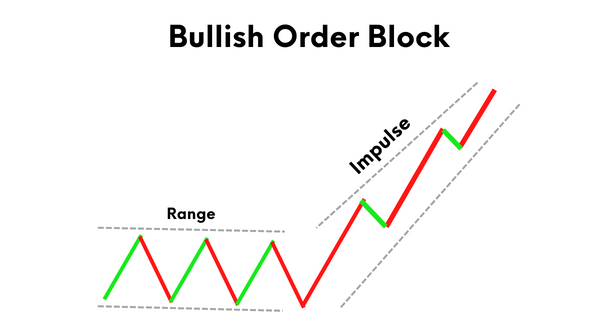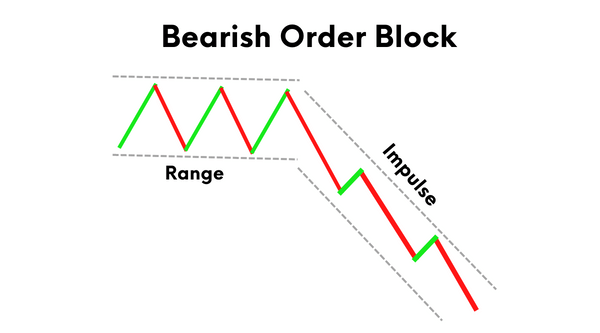Order Blocks Explained: How Smart Money Leaves Clues in the Market
Order blocks are powerful zones where institutions quietly accumulate orders. Learn to spot and trade these key price action zones for precise entries and exits.

“It's not the daily increase but daily decrease. Hack away at the unessential.” – Bruce Lee
How to Trade Order Blocks Like Smart Money: The Ultimate Guide
When retail traders look at the markets, they see candles, patterns, and indicators. But institutions see something deeper: liquidity zones, often referred to as order blocks. Understanding these powerful areas can transform your trading, allowing you to enter alongside institutional flows rather than being caught in retail traps.
This ultimate guide explains exactly what order blocks are, how smart money traders use them, and how you can identify and trade them to significantly boost your trading success.
Key Takeaways:
- Order blocks reveal areas where institutions place large trades.
- They often signal future price direction when retested.
- Not all blocks are equal, context and confluence matter.
- High R:R setups can form at valid order blocks.
- Differentiating order blocks from simple support/resistance zones improves precision.
What Exactly Are Order Blocks?
An order block is a clearly defined zone where major institutions—banks, hedge funds, and other large players—have entered substantial buy or sell positions. These positions often reverse or significantly move the market.
Visually, a bearish order block is typically the last bullish candle before a dramatic move down, while a bullish order block is the last bearish candle before a significant upward price surge.

Why Institutions Use Order Blocks
Institutions deal in massive volumes. They cannot execute these enormous orders in one go because it would move prices unfavorably. Instead, they quietly build positions within small ranges or zones. These zones are your order blocks.
Smart money traders place their entries and stops strategically, knowing exactly how retail traders think. They often manipulate price to revisit these zones, collect liquidity (trigger retail stops), and then move aggressively in the intended direction.
How to Identify High-Quality Order Blocks
Identifying an effective order block requires careful analysis:
- Significant Price Movement:
- Look for large, impulsive moves.
- The stronger and clearer the move, the more reliable the order block.
- Locate the Origin:
- Mark the last opposite candle before this strong movement.
- Draw Your Zone:
- Highlight the body of this candle (open and close).
- Future Price Reaction:
- Watch how price reacts when it returns to this zone.
Summary Table: Steps to Spot an Order Block
| Step | Action | Description |
|---|---|---|
| 1 | Look for a strong move | Identify a large bullish or bearish impulse move with clean structure. |
| 2 | Identify the last candle before the move | That’s often the origin of the institutional order. |
| 3 | Mark the high and low of that candle | This forms the visual “block.” |
| 4 | Wait for price to return | Look for a retracement to the block for a possible entry. |
| 5 | Confirm with confluence | Use indicators (e.g., RSI divergence or FVG) or time-of-day alignment. |
Types of Order Blocks
- Bullish Order Blocks: Form before significant upward moves.
- Bearish Order Blocks: Form before notable downward moves.
Order Blocks vs Support and Resistance
While both concepts involve areas where price reacts, order blocks are more refined. Traditional support and resistance are drawn based on price touches or round numbers. Order blocks, however, represent zones where institutions have placed significant orders. This makes them more reliable in many cases, especially when combined with volume or price action confirmation.
Key differences:
- Support/Resistance: Based on horizontal price levels, often tested multiple times.
- Order Blocks: Origin of a large price move, usually with limited tests and higher reaction.
Think of support/resistance as crowd memory, and order blocks as smart money footprints.
How to Trade Order Blocks Step-by-Step
Step 1: Confirm Higher Timeframe Bias
Always check higher timeframes (daily, 4-hour, 1-hour) for market context. Identify clear trends, key market structure levels, and notable order blocks.
Step 2: Identify Clear Order Blocks on Your Trading Timeframe
Look for defined bullish or bearish blocks that led to substantial price movements.


Step 3: Wait Patiently for Retests
Don't chase. Let price return to the order block. Institutions frequently revisit these areas to complete their accumulation or distribution.
Step 4: Look for Entry Confirmation
Use price action signals like bullish/bearish engulfing patterns, pin bars, or volume increases to confirm entries when price touches the order block.
(See our guide on Candlestick Patterns for more details.)
Step 5: Manage Your Risk
Always place Stop Losses just beyond the order block to protect your capital.
Powerful Example: Trading an Order Block
Imagine a bearish order block on the EUR/USD chart at 1.1000. After a sharp decline from this level, the price returns. Watching closely, you see bearish rejection candles and increased selling volume at this retest.
Enter short just below the rejection candle, with a tight stop above the order block. Your target? Recent support levels or a 2:1 risk-reward ratio.
Common Mistakes When Trading Order Blocks
- Trading Unclear Blocks: Stick to blocks associated with strong impulsive moves.
- Ignoring Market Structure: Always align order blocks with overall market direction.
- Poor Risk Management: Tight stops and disciplined exits protect your edge.
(Review our Risk Management guide to master this.)
Combining Order Blocks with Other Tools
Order blocks gain power with confluence:
- Volume Profile: Confirms strong institutional presence.
- RSI Divergences: Highlights momentum shifts at order blocks.
- Breakout Strategies: Signals clear entries when blocks align with breakout points.
(Check our Breakout Strategies article for deeper insights.)
The Psychology Behind Trading Order Blocks
Institutions count on retail traders’ emotions—greed, fear, impatience—to create predictable liquidity zones. To beat them, you must trade calmly and systematically:
- Trust your strategy.
- Wait patiently for clear setups.
- Avoid emotional entries/exits.
Mastering this mindset boosts your trading success.
Conclusion
By following this structured approach, you'll start seeing markets through the eyes of smart money. Not every trade will win, but your overall probability and confidence will improve dramatically.
Remember, great trading isn't about catching every move, it's about catching the high-quality moves that offer you an edge.
Ready to keep leveling up your trading? Dive deeper with these articles:
- Stop Losses for safe trading
- Breakout Strategies for market momentum
- Candlestick Patterns for entry confirmation
- Volume Analysis for validating moves
- Risk Management to protect your trading career
Trade smart, trade strategically, and let order blocks guide you to consistent success.
FAQs
Q1: Can I trade order blocks alone without indicators?
Yes, but confirmation tools like volume or price action improve your win rate.
Q2: Are all large candles considered order blocks?
No — only the ones preceding a strong market structure break or imbalance.
Q3: Which timeframes work best for spotting order blocks?
Higher timeframes (H1, H4, Daily) offer stronger blocks, while lower ones help refine entries.
Q4: How do I know if an order block has been “used up”?
If price has revisited the block multiple times without reaction, it's likely invalidated.
Q5: Do retail platforms like TradingView help in spotting order blocks?
Yes. You can manually mark candles or use smart money concept indicators available on TradingView.




